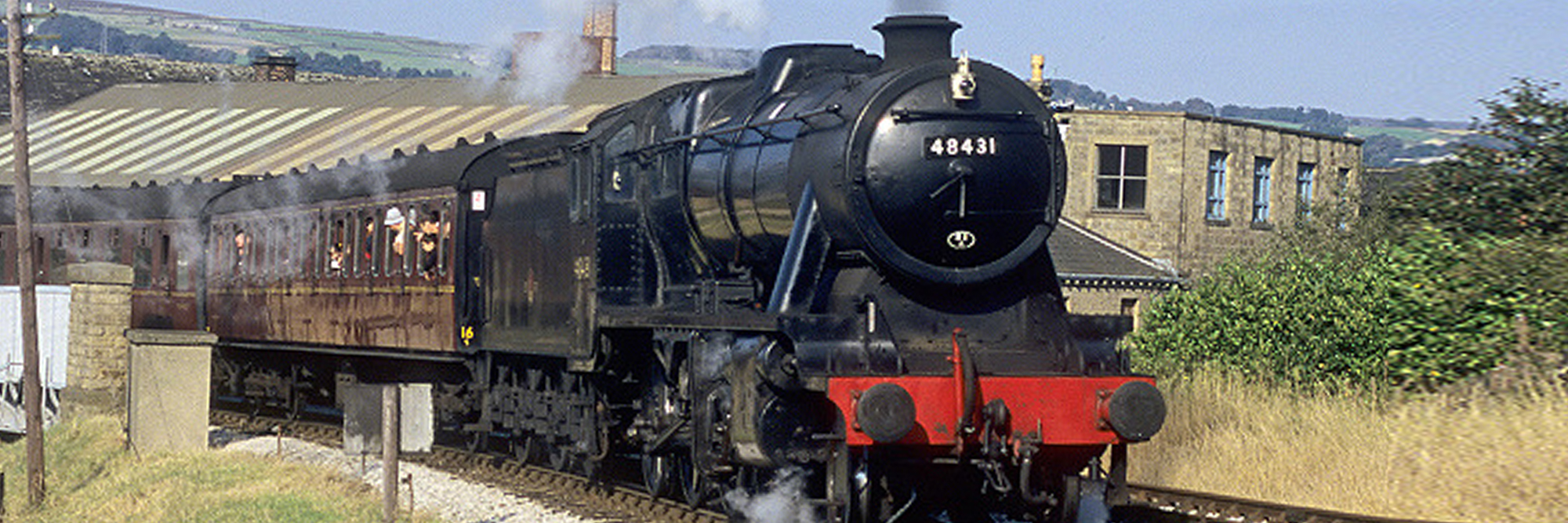An LMS engine from the GWR headquarters
Prior to designing the WD (see 90733) the 8F was chosen as the standard heavy freight design for war work in WW2. 8Fs were built by all the major railway companies with no. 8431 being built by the Great Western Railway at Swindon in 1944.
Although an LMS locomotive, 8431 was allocated to Western sheds throughout most of its life. Along with 90733 and 5820, 8431 makes up the only 2-8-0 trio of locomotives built for service in the Second World War, a unique collection. Although restored twice in preservation, the amount of work required to bring 48431 back into service a third time, prohibits an early return to action.
Data File
Built: 1944 Swindon
Boiler Pressure: 225 psi
Tractive Effort: 32,440 lbf
Weight 72.1 tons engine 56.35 tons tender
Valve Gear: Walschaerts
Cylinders: 18½”x28″ Outside
Numbers carried during working career: LMS 8431, BR 48431
From wartime through to the scrapyard
The 8F class was originally designed by William Stanier soon after his arrival with the company. A weak area of locomotive availability was identified in heavy freight engines and so the design first appeared in 1935 only a few months after the introduction of Class 5 mixed traffic engines.
The class was initially chosen by the Ministry of Supply during the Second World War as the standard heavy freight design for war work. All the major railway companies of the time produced these engines and in 1944 no. 8431 was one of 80 built by the GWR at Swindon. Having been used by the GWR on entering service, it was based at Newton Abbot and Gloucester until 1947 when it was transferred to the (South) Yorkshire depot of Royston. The engine was taken into British Railways ownership upon nationalisation in 1948, with 4 added to its number as 48431. In September 1955 the engine was transferred back to the Western Region and was based at Bristol (St. Philip’s Marsh), London (Old Oak Common, 1960), back to Bristol (Barrow Road, 1962) and, finally, Bath (Green Park, January 1964) until its withdrawal from service five months later.
Like over 200 others, no 48431 was sold to the Barry scrapyard of Woodham Bros. and was towed to South Wales to await its appointment with destiny.
The 19th engine to be rescued from Barry
Arriving in South Wales in August 1964, 48431 spent the next eight years ‘enjoying’ life by the coast, until purchased by the KWVR in March 1971. It was removed from Barry and arrived by road at Haworth in May 1972. Unlike most later departures from Barry, the engine did come with coupling and connecting rods. On initial purchase, the engine was regarded as a long term restoration project by the Society, but after much dedication and hard work, however, the engine had been steam-tested at Haworth by the end of 1974 and re-entered service as LMS 8431 in December 1975.
The engine has performed passenger and demonstration freight turns over the years on the KWVR and in May 1985, took part in the GWR 150 celebrations at the Didcot Railway Centre. 48431 was finally withdrawn on the expiration of its boiler certificate after a second restoration and now is considered, as it was when it first arrived, as a long term restoration project. The locomotive is now on display as a static exhibit in Oxenhope Exhibition shed.
